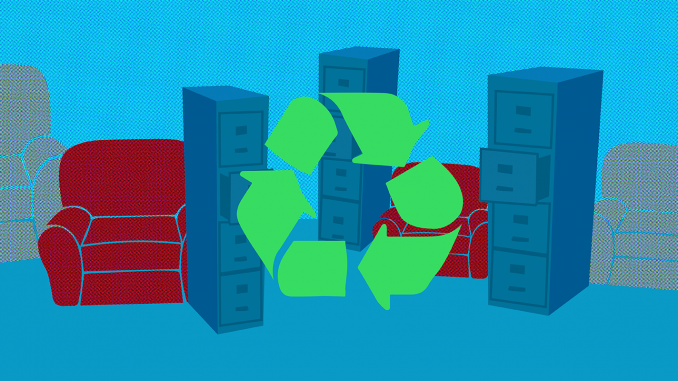
The majority of things I own come to me secondhand. From books that I find used online to clothes that I buy from thrift stores, almost everything that is now mine has had a life before me.
What’s great about thrifting, or buying used items is that it’s not only cheaper, but it keeps products that are still in good condition out of landfills, allowing them to find new use.
As an environmental studies major and someone who cares about the world we live in, I’m always trying to find new ways to minimize waste in my life. And I’m slowly setting goals for myself to reduce my carbon footprint by buying anything I can secondhand.
But I also want to help others reduce their footprint as well. One of the most challenging ways I’ve been trying to reduce waste recently has been by working in Temple’s surplus warehouse, the place where furniture from on-campus buildings is discarded when no longer is use.
There’s something organic about giving a new life to these untouched pieces of furniture and watching as they are reused by different departments on campus, nonprofit organizations throughout the city and in random homes.

SASHA LASAKOW / THE TEMPLE NEWS
Even the pieces that I think are hopeless heaps of garbage find new havens. Working in the warehouse has allowed me to see the bigger picture when it comes to reducing waste. While my personal environmentally conscious habits are important, it’s even more gratifying to see a large institution like Temple reducing its impact.
And I’m glad I can be part of this work. There are no boring days in the warehouse. Sometimes my co-workers and I laugh in frustration when we receive more filing cabinets to add to our existing plethora. Other times, we get caught up examining old laboratory equipment.
A typical day at the warehouse is exhausting though. There’s no air conditioning, and everything is dirty and dusty. Not a day goes by that I’m not moving objects twice my size, from 80-pound filing cabinets to bulky wooden desks.
The process of reselling this furniture isn’t fun either. It’s often monotonous: taking photos of the pieces and creating listings. Most items are sold for less than $10 to make sure they find a new home, but these small successes are far better than the wasteful alternatives.
Wherever the items end up, it’s gratifying to know they didn’t end up sitting in a landfill or being shipped off to other locations to sit as waste there. By finding new life for these items, we allow these items to continue being used, so that more products do not have to be made.
If this job has taught me anything, it’s that everything can be used and reused in some way. We live in a throw-away culture, and consumerism preaches that we constantly need to upgrade our stuff. From clothes to furniture and electronics, our landfills are piled with perfectly useful materials that are deemed unfit, despite still being in good condition.
While I can’t save every piece of furniture that comes across the warehouse or stop people from sending their items away as waste, I’ll try my best. And I’ll continue my own waste-reducing habits in the meantime.



Be the first to comment